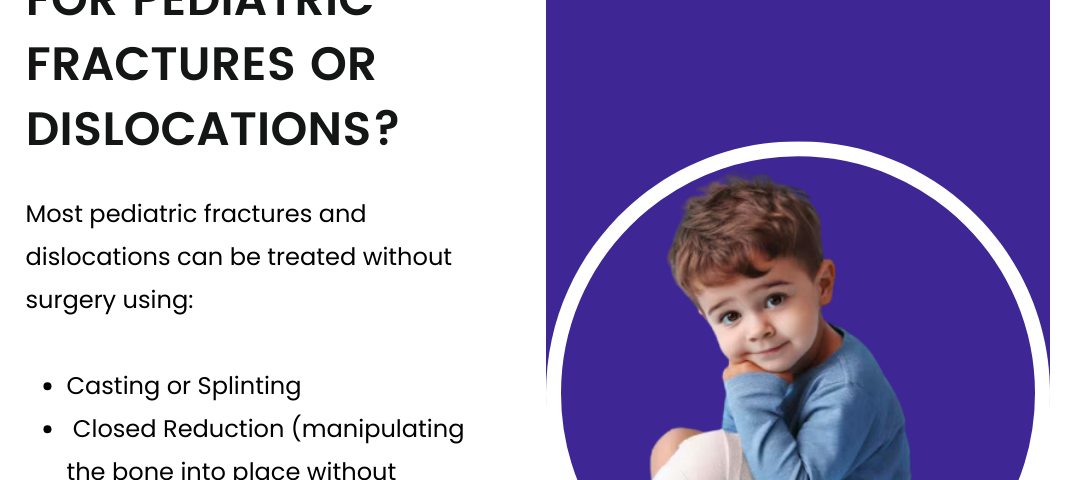Children are active, playful, and naturally prone to falls and injuries. As a parent, seeing your child suffer a fracture or dislocation can be terrifying.
One common question parents ask is: “Will my child need surgery for this?”
The good news is that most pediatric fractures and dislocations heal very well with simple treatments. However, in some cases, surgery might be necessary. Let’s dive deeper into when surgery is required and how pediatric bone injuries are managed.
Understanding Pediatric Fractures and Dislocations
- Fractures are breaks or cracks in bones.
- Dislocations occur when a bone slips out of its joint.
Children’s bones are very different from adult bones. They are more flexible, can absorb shock better, and have a growth plate (an area near the ends of long bones) which allows for continued bone development.
Because of these differences, children’s bones heal faster and can often correct small misalignments on their own during growth.
Common Causes of Fractures and Dislocations in Children
- Falls from playground equipment
- Sports injuries
- Bicycle accidents
- Minor household accidents
- Trampoline accidents
When Is Surgery NOT Needed?
Most pediatric fractures and dislocations can be treated without surgery using:
Casting or Splinting
Closed Reduction (manipulating the bone into place without surgery)
Slings or braces for support
Simple fractures — like buckle fractures or minor hairline fractures — usually heal beautifully with proper immobilization and time.
When Is Surgery Needed for Pediatric Fractures or Dislocations?
Surgery is considered only when necessary to ensure correct healing and avoid future complications.
Some situations where surgery may be needed include:
1. Severely Displaced Fractures
If a bone is significantly out of place and cannot be realigned properly without an operation, surgical intervention (often using pins, plates, or screws) is recommended.
2. Growth Plate Injuries
If the fracture involves the growth plate, precise alignment is crucial to ensure the bone grows normally. In some cases, surgery helps prevent future deformities.
3. Open (Compound) Fractures
When the broken bone pierces the skin, there’s a high risk of infection. Surgery is necessary to clean the wound and stabilize the bone.
4. Fractures That Fail to Heal Properly
Rarely, a fracture may not heal correctly with casting alone. In such cases, surgical correction may be needed.
5. Complex Joint Dislocations
While many dislocations can be reduced without surgery, complicated or unstable joint injuries might require surgical repair, especially if there are associated fractures.
Types of Pediatric Fracture Surgeries
Closed Reduction and Pinning:
The surgeon aligns the bones without making a big incision and uses pins to hold them in place.
Open Reduction and Internal Fixation (ORIF):
When closed methods aren’t enough, an incision is made to directly fix the fracture with plates, screws, or rods.
External Fixation:
In certain cases, a frame outside the body is used to stabilize the bone while it heals.
How Do Doctors Decide If Surgery Is Needed?
Dr. Rajesh Panchal and other pediatric orthopedic experts follow a detailed evaluation process:

Recovery After Pediatric Fracture Surgery
Thankfully, children’s bodies are very resilient. Post-surgery, most children:
- Wear a cast or brace for a few weeks
- Have regular follow-up X-rays
- Resume normal activities gradually
Physical therapy may be recommended in some cases to regain full strength and motion.
Most children recover completely and go back to their active lifestyles without any long-term issues.
FAQs About Pediatric Fracture and Dislocation Treatment
Modern surgical techniques are very safe when performed by experienced orthopedic surgeons. Risks are low but can include infection, anesthesia reactions, or improper healing.
Rarely. Sometimes pins or plates are removed once the bone is fully healed, but often, no further surgery is needed.
Depending on the injury, full healing typically takes 6 to 12 weeks.
If a growth plate injury is treated correctly early on, growth usually continues normally. Untreated or severe injuries can lead to growth disturbances.
Conclusion
While hearing that your child has a fracture or dislocation can be overwhelming, remember:
Most pediatric injuries heal extremely well without surgery.
In cases where surgery is needed, it is done carefully to ensure the best long-term outcomes.
Early assessment and expert care are critical. If your child has suffered a fracture or dislocation, trust an experienced pediatric orthopedic surgeon like Dr. Rajesh Panchal for compassionate, specialized treatment.
Worried about your child’s fracture or injury?
Schedule a consultation with Dr. Rajesh Panchal today!






